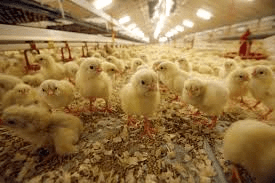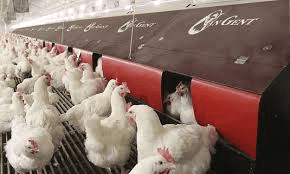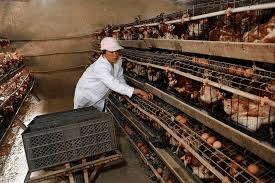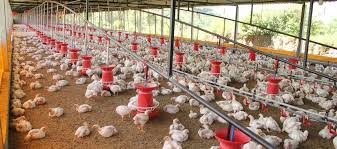Prospective poultry farmers are advised to make arrangement for their housing before arrival of poultry chicks. Considering their age “Day Old” (D.O.C), the kind of housing in which they will start their lives should not be over looked because young chicks need more care than the adult growers or layers.
Baby chicks are really quite easy to raise. With a few pieces of equipment and a small place to put them, success in brooding and rearing is virtually assured. During this period of the bird’s life, the most important needs are for warmth, protection, feed, and water.
When growing chicks of any species-chickens, turkeys, pheasants, or almost any other production bird-each of these aspects must be considered.
Suitable poultry housing is very important for successful poultry farming business. Poultry birds can be raised in both free range and indoor production systems. In case indoor production system, it is very crucial to manage the environment.
Poultry need accurate management and environment for better production and welfare. Whether the poultry raised in indoor or outdoor system, make sure the well management, ventilation, lighting, temperature and litter condition.
For a small scale poultry production, portable houses are best and this is an organic method. But for sustainable commercial poultry production, planned and proper designed poultry housing is very essential to keep the poultry birds healthy and productive. And this will increase the farming production and income.
In fact, there are no hard and fast rules on the choice of site for the poultry houses. Rearing houses could be backyard, garages, parts of a dwelling house or vacant rooms.
However, commercial producers should consider the following list below:
1) The poultry houses should be sited on well drained soil to reduce the cost and avoid dampness in order to reduce the incidence of diseases and also the risk of attack by soldier ants.
Clean water should be available at the site and the site must be easily accessible to facilitate delivery of chicks and removal of poultry products for sale.
2) It does not matter what type of building used but the following list must be considered also:
a) Adequate ventilation and sufficient lights
b) Floor of the poultry houses must be concrete and filled with dried litter.
c) Birds should be protected from bad weather conditions.
Read Also: How to Control and Prevent Disease Outbreak on your Poultry Farms
Reasons for Housing Chicks

Chicks that are not housed would be exposed to some hazards and they are housed to protect them from the following:
1. Bad weather conditions
2. Thieves at night
3. Wild animals like carnivorous mammals
4. To facilitate easy control
5. To keep them in age group because older chicks kept with younger ones cause disorder like pecking which can result in their premature/avoidable death and this can cause unexpected loss to the poultry farmer.
Natural vs. Artificial Brooding
In nature, chicks hatch after 2 to 4 weeks of incubation by the parents, most often the hen. The hatched chicks provide the stimulus to the hen to change her work from incubating eggs to brooding young. This form of brooding chicks is the easiest if only a few chicks are raised because the mother hen does all the work.
Hens that are “good mothers” include Rhode Island Red, New Hampshire, Plymouth Rock, Cochins, and Silkies. Under natural brooding, chicks can easily be fostered under a broody hen at night, and she will raise them as her own even if they are pheasants, turkeys, quail, or waterfowl.
When broody hens are not available, or large numbers of chicks are to be raised, artificial brooding is necessary. Chicks will perform equally well under artificial or natural brooding, providing they are precocial; that is, able to walk and feed themselves within hours of hatching, as baby chickens are.
Novice growers are not advised to try artificial brooding for altricial chicks; that is, chicks such as pigeons, doves, finches, and parrots that remain in the nest to be cared for and fed by the parents.
Many of these chicks are naked, blind, and unable to walk for several weeks after hatching and require around-the-clock care and feeding.

Read Also: Recommended Brooding Duration for Chicks with Temperature Requirement
Brooder Size
New chicks require at least ½ square foot of space per bird, but that number will double within a month. By 8 weeks, 1 ½ – 2 square feet will be needed to give these growing peeps room to romp.
While chicks may be transferred into larger enclosures as they develop, it’s usually easier to start with a pen that will accommodate them throughout the brooding process.
Find or construct a container appropriate to the number of chicks and with sides 12-18 inches high to discourage birds from “going over the wall” as their wings develop.
Location
Find a warm, dry and well-ventilated location to set up the brooder. Adult birds may injure growing chicks, so a brooder placed inside an existing coop should be isolated from the flock using chicken wire.
Garages, sunrooms or ventilated outbuildings all make great locations for this temporary housing. Make sure the brooder is protected from potential intruders like snakes, raccoons or house pets.
If security is an issue, old window screens may be anchored on top of the brooder to protect chicks from potential predators.
Temperature
New chicks require plenty of warmth. Hang a 250 watt bulb about 18 inches above the floor of the brooder. As chicks develop, this additional heat source won’t be necessary. Watch chick behavior.
The temperature below the lamp should be about 90 degrees for the first week and the lamp may be raised to reduce the temperature by 5 degrees each week until the pen reaches room temperature.
Bedding

For the first few days, only paper towels, newspaper or burlap should be used to line the brooder to give chicks better footing and to make it easy for them to identify food (chicks may mistake loose bedding for food).
By the end of the first week, wood shavings can be added at a depth of 1-2 inches to the brooder to provide a soft, absorbent bedding. Bedding should be changed regularly to make sure the brooder remains clean, dry and relatively odor-free.
Food and Water
Provide feeders and waterers designed for small chicks. Waterers must be shallow to prevent accidental drowning and feeders low enough for easy access.
Use “starter” feed, which is higher in protein than conventional layer feed and will help birds develop. When introducing chicks to the brooder, dip their beaks in water to help them identify the source.
A well-maintained brooder will offer growing chicks everything they need until they are ready to join the gang in the coop. It usually takes about two months until growing chickens are fully feathered and strong enough to leave the brooder, but they may be ready as early as six weeks.
Once fully-feathered, if birds begin to peck at each other or are easily escaping the brooder by flying over the confines, it may be time to introduce them to the rest of the flock.
Read Also: Quail Eggs – The Super Food (34 Amazing Health Benefits)
Brooding Chickens and Quail
Poultry and game bird producers realize that chicks must be kept warm or brooded during the first weeks of life. Surprisingly, improper brooding is one of the most common causes of stress in poultry flocks.
Three basic methods are used to brood chicks.
1. Spot Brooding – The chicks have localized heat source and access to a cooler, unheated area. The chicks determine their own heating needs by moving from hot to cold areas and vice versa.
2. Whole House Brooding – A large area around the brooders is warmed to the same temperature when whole house brooding. The chicks have no choice between warm and cool areas.
3. Partial‐House Brooding ‐ Partial‐house brooding is much like whole house brooding, since the total brooding area is warmed. To save energy, however, the brooding area is reduced to the minimum amount needed for the size of chicks.
As the chicks grow, the brooding area is increased in accordance to their sizes. Good ventilation is essential with all brooding systems but especially partial‐house brooding.
Light the brooders 24 hours before the chicks hatch or arrive. Determine if the brooders are working properly, and adjust the temperature to 90 to 95 °F below the outer edge of the brooder (1 inch above the litter).
In time of stress or vaccination reactions, increase brooder temperatures about 5 ° above the recommended temperature until the chicks recover.
Place an 18-inch-high, solid-type brooder guard around each brooder. Locate the guard 3 to 4 feet from the edge of the brooder. The guard prevents floor drafts and keeps chicks near the heat.
In summer, enlarge the ring to keep chicks from getting too hot. Expand the guard a little each day (about 20 to 25 percent total area increase) until it is no longer needed after 7 to 14 days.
Corrugated cardboard makes an excellent brooder guard and can be discarded when it becomes soiled. In hot weather, hardware cloth or similar mesh material may be used instead of solid guard. Most of these guards are cleaned, disinfected, and reused.
Place an adequate number of feeders and waterers around each brooder. Provide at least two 1- gallon waterers and two 12-inch or 18-inch chick feeders for every 100 chicks. Feed placed on a few feeder lids or egg flats under each brooder encourages the chicks to start eating sooner.
Sprinkle a pile of feed on each lid before placing chicks under brooder. Remove lids when all feed is eaten or after 4 to 6 days.
Place long waterers or feeders in the brooding area, pointing toward the heat source. If placed parallel to the brooder guard, small chicks may be prevented from returning to the warmth. (At 1 day of age, they have not learned they sometimes have to go around a long object to get back to the warmth.)
Placing feeders in a “wagon spoke” fashion also insures that a section of each feeder is always in a comfort zone. Locate the inner end of the feeder under or slightly outside the outer edge of the brooder or hover.
Never place all the waterers and feeders directly under the brooder. The area under the brooder must be kept clear for brooding the chicks.
The day-old chick’s temperature is about 3 °F below that of an adult’s. Its body temperature starts rising about 4 days of age and reaches its maximum at 10 days.
Read Also: Why Eggs Are Good For You – The Exceptional Super Food for Your Health
The chick needs time to develop temperature control (2 to 4 weeks). As the chick grows older, the downy coat is replaced with feathers, and brooder temperature must be reduced according to the temperature schedule.
Brooding Temperature Schedule
Age (in Days)
Brooder Temperature (F)
Summer
Winter
1 – 7
90
95
8 – 14
85
90
15 – 21
80
85
22 – 28
75
80
29 – 35
70
75
36 – Market
70
70
Under this brooding schedule, the brooding temperature is reduced 5 °F each week. At 5 weeks of age, chicks maintain their own body temperatures if the room temperature is kept near 70 degrees.
Use lower brooding temperatures during warm months. Most poultry houses are not tight enough to maintain these temperatures constantly in winter. Insure adequate warmth in winter by using the higher brooding temperature; when cold nights cool the house, chicks are likely to have enough warmth.
In contrast to what many think, the most frequent error observed when brooding in the South is overheating rather than too little heat. Many producers need to learn proper brooding to reduce losses.
Check the comfort of the chicks several times each day, especially in the evening. Make adjustments to maintain chick comfort. Contented peeping and even distribution of chicks around and under the brooder indicate comfortable conditions.
If the chicks chirp and huddle to one side of the brooder, there is a draft. When the temperature is too cold, the chicks chirp sharply and huddle together under the brooder. If the chicks move away from the brooder, pant, and are drowsy, the temperature is too warm.
With steadily increasing energy costs, a strong emphasis must be placed on sound brooder management and operation. Some tips for conserving energy are listed.
• Use the correct brooder height, as recommended by the brooder manufacturer. A higher brooder adjustment increases fuel usage, while lower brooder adjustment increases the danger of igniting flammable litter and burning the chicks. Maintain a minimum clearance of 5 to 6 inches over the chicks’ backs.
• Use dry litter material for brooding. Additional energy is needed to evaporate moisture.
• Check the accuracy of brooder thermostats and thermometers to insure proper heat for the chicks.
• Solid brooder guards keep the heat closer to the brooder.
• Place brooders near the center of the house. This reduces heat loss through walls and prevents drafts.
• Frequently clean burner orifices, adjust pilot lights, and check for proper gas line pressure.
• Brood the maximum number of chicks under each brooder, but do not overcrowd.
• Shut off half the brooder pilot lights when all the brooders are no longer needed. The best practice is to turn off every other brooder. The remaining brooders help prevent serious problems if internal house temperatures drop suddenly.
Read Also: 12 Management Tips for better Poultry Performance Potential
Frequently Asked Questions
We will update this section soon.

